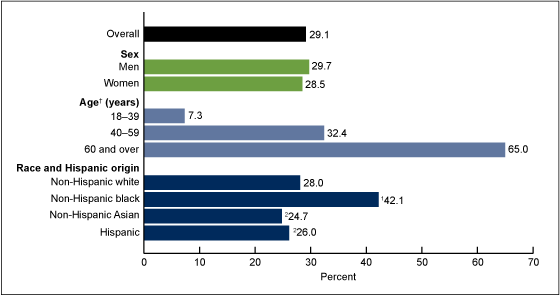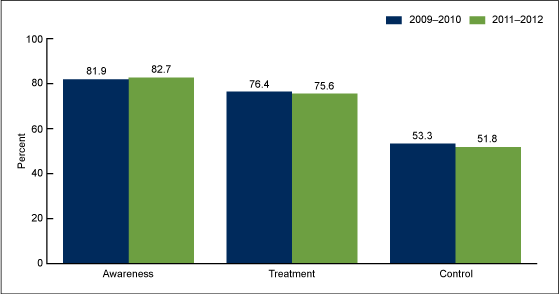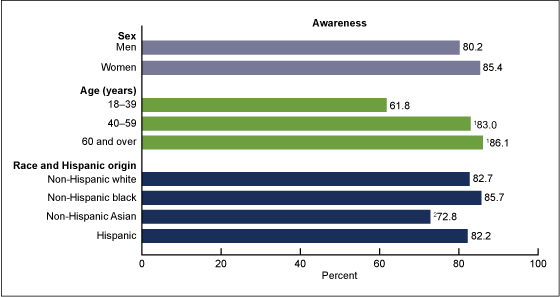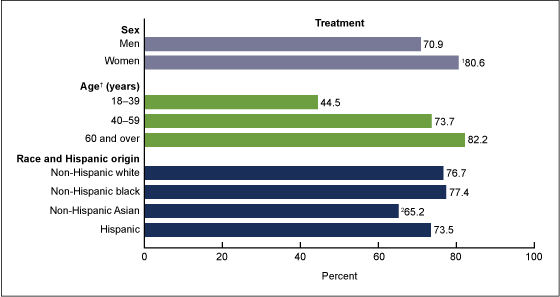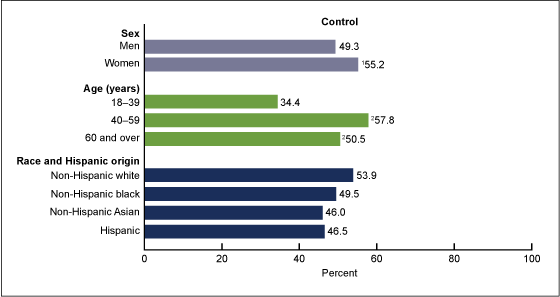Hypertension Among Adults in the United States: National Health and Nutrition Examination Survey, 2011–2012
- Key findings
- What was the prevalence of hypertension among U.S. adults, and were there differences by age, sex, or race and Hispanic origin?
- Has overall awareness, treatment, and control of hypertension changed since 2009–2010?
- Did awareness of hypertension among U.S. adults with hypertension differ by age, sex, or race and Hispanic origin in 2011–2012?
- Did treatment of hypertension among U.S. adults with hypertension differ by age, sex, or race and Hispanic origin in 2011–2012?
- Did control of hypertension among U.S. adults with hypertension differ by age, sex, or race and Hispanic origin in 2011–2012?
- Summary
- Definitions
- Data source and methods
- About the authors
- References
- Suggested citation
NCHS Data Brief No. 133, October 2013
PDF Version (778 KB)
Tatiana Nwankwo, M.S.; Sung Sug (Sarah) Yoon, Ph.D., R.N.; Vicki Burt, Sc.M., R.N.; and Qiuping Gu, M.D., Ph.D.
Key findings
Data from the National Health and Nutrition Examination Survey, 2011–2012
- The age-adjusted prevalence of hypertension among U.S. adults aged 18 and over was 29.1% in 2011–2012, similar to the prevalence in 2009–2010.
- The prevalence of hypertension was similar for men and women at nearly one-third. The prevalence increased with age and was highest among older adults; it was also highest among non-Hispanic black adults, at approximately 42%.
- Among adults with hypertension, nearly 83% were aware, nearly 76% were taking medication to lower their blood pressure, and nearly 52% were controlled. There was no change in awareness, treatment, and control from 2009–2010 to 2011–2012.
- Controlled hypertension was similar across race and Hispanic origin groups, but the percentage controlled was higher for women and older adults.
Hypertension is an important risk factor for cardiovascular disease and affects almost one-third of the U.S. adult population (1). In 2009–2010, nearly 82% of adults with hypertension were aware of their status, and nearly 76% were taking medication (2). Despite considerable improvement in increasing the awareness, treatment, and control of hypertension, undiagnosed and uncontrolled hypertension among minority groups remains a challenge (3–5). This report presents survey results for 2011–2012 on the prevalence, awareness, treatment, and control of hypertension.
Keywords: high blood pressure, awareness, treatment, control
What was the prevalence of hypertension among U.S. adults, and were there differences by age, sex, or race and Hispanic origin?
- The overall prevalence of hypertension among U.S. adults aged 18 and over was 29.1% in 2011–2012 and was similar among men (29.7%) and women (28.5%) (Figure 1).
- The prevalence of hypertension increased with age, from 7.3% among those aged 18–39, to 32.4% among those 40–59, to 65.0% among those 60 and over.
- The prevalence of hypertension was highest among non-Hispanic black adults (42.1%), compared with non-Hispanic white (28.0%), Hispanic (26.0%), and non-Hispanic Asian (24.7%) adults.
Figure 1. Age-specific and age-adjusted prevalence of hypertension among adults aged 18 and over: United States, 2011–2012
† Significant linear trend.
1Significantly different from non-Hispanic white.
2Significantly different from non-Hispanic black.
NOTE: Estimates were age-adjusted by the direct method to the Census 2000 population, using the age groups 18–39, 40–59, and 60 and over.
SOURCE: CDC/NCHS, National Health and Nutrition Examination Survey, 2011–2012.
Has overall awareness, treatment, and control of hypertension changed since 2009–2010?
- During 2011–2012, among adults with hypertension, 82.7% were aware of their hypertension, 75.6% reported currently taking prescribed medication to lower their blood pressure, and 51.8% had their blood pressure controlled (Figure 2).
- There was no significant change from 2009–2010 in awareness, treatment, or control among adults with hypertension.
Figure 2. Age-adjusted awareness, treatment, and control of hypertension among adults with hypertension: United States, 2009–2012
NOTE: Age-adjusted prevalence of awareness, treatment, and control of hypertension were calculated using the subpopulation of persons with hypertension in 2011–2012.
SOURCE: CDC/NCHS, National Health and Nutrition Examination Survey, 2011–2012.
Did awareness of hypertension among U.S. adults with hypertension differ by age, sex, or race and Hispanic origin in 2011–2012?
- Men (80.2%) and women (85.4%) were alike in their awareness of hypertension (Figure 3).
- Among adults with hypertension, awareness of hypertension among those aged 18–39 (61.8%) was lower than for those aged 40–59 (83.0%) and 60 and over (86.1%).
- Non-Hispanic Asian adults with hypertension were less aware of their condition (72.8%) than were non-Hispanic black (85.7%), Hispanic (82.2%), and non-Hispanic white (82.7%) adults.
Figure 3. Age-specific and age-adjusted awareness of hypertension among adults with hypertension, by sex, age, and race and Hispanic origin: United States, 2011–2012
1Significantly different from those aged 18–39.
2Significantly different from non-Hispanic white, non-Hispanic black, and Hispanic.
NOTE: Age-adjusted prevalence of hypertension awareness was calculated using the subpopulation of persons with hypertension in 2011–2012.
SOURCE: CDC/NCHS, National Health and Nutrition Examination Survey, 2011–2012.
Did treatment of hypertension among U.S. adults with hypertension differ by age, sex, or race and Hispanic origin in 2011–2012?
- More women (80.6%) than men (70.9%) reported taking antihypertensive medication. (Figure 4).
- Current use of medication to lower blood pressure increased with age: 44.5% for those aged 18–39, 73.7% for those 40–59, and 82.2% for those 60 and over.
- Non-Hispanic Asian adults with hypertension were less likely to report taking antihypertensive medication (65.2%) than were non-Hispanic black (77.4%) and non-Hispanic white (76.7%) adults.
Figure 4. Age-specific and age-adjusted treatment of hypertension among adults with hypertension, by sex, age, and race and Hispanic origin: United States, 2011–2012
† Significant linear trend.
1Statistically different from men.
2Statistically different from non-Hispanic white and non-Hispanic black.
NOTE: Age-adjusted prevalence of treated hypertension was calculated using the subpopulation of persons with hypertension in 2011–2012.
SOURCE: CDC/NCHS, National Health and Nutrition Examination Survey, 2011–2012.
Did control of hypertension among U.S. adults with hypertension differ by age, sex, or race and Hispanic origin in 2011–2012?
- The percentage of controlled hypertension among adults was higher for women (55.2%) than for men (49.3%) (Figure 5).
- Among adults with hypertension, those aged 18–39 (34.4%) were less likely to have controlled blood pressure than those 40–59 (57.8% ) or 60 and over (50.5%).
- However, there was no difference in controlled hypertension among adults in the different race and Hispanic origin groups: non-Hispanic Asian (46.0%), Hispanic (46.5%), non-Hispanic black (49.5%), and non-Hispanic white (53.9%).
Figure 5. Age-specific and age-adjusted control of hypertension among adults with hypertension, by sex, age, and race and Hispanic origin: United States, 2011–2012
1Statistically different from men.
2Significantly different from those aged 18–39.
NOTE: Age-adjusted prevalence of hypertension control was calculated using the subpopulation of persons with hypertension in 2011–2012.
SOURCE: CDC/NCHS, National Health and Nutrition Examination Survey, 2011–2012.
Summary
The overall prevalence of hypertension has not changed appreciably since 2009–2010. The age-adjusted prevalence of hypertension among U.S. adults was 29.1% in 2011–2012. Among adults with hypertension in 2011–2012, 82.8% were aware of their hypertension, 75.7% were currently taking medication to lower their blood pressure, and 51.9% had their blood pressure controlled to less than 140/90 mm Hg.
Men and women had similar prevalence and awareness of hypertension, but more women than men were treating their hypertension and had it under control. Young adults aged 18–39 continued to have lower awareness, treatment, and control of their hypertension compared with older adults.
Hypertension prevalence was still highest among non-Hispanic black adults. However, awareness, treatment, and control of hypertension were similar among non-Hispanic black, non-Hispanic white, and Hispanic adults. Non-Hispanic Asian adults had a lower prevalence of awareness than the other race and Hispanic origin groups, and lower treatment than non-Hispanic white and non-Hispanic black adults. However, hypertension control was similar among non-Hispanic Asian adults and the other race and Hispanic origin groups.
Hypertension is a common and manageable chronic condition. Based on recent national data from 2011–2012, treatment of hypertension exceeded the Healthy People 2020 target goal of 69.5%. However, the control of hypertension has neither met the goal of the Healthy People 2020 (61.2% by 2020) nor the Million Hearts Initiative (65% by 2017). These results provide evidence for continued efforts to improve the management of hypertension in order to attain these goals (6,7).
Definitions
Hypertension: Systolic blood pressure of 140 mm Hg or above, or diastolic blood pressure of 90 mm Hg or above, or currently taking medication to lower blood pressure (8,9).
Awareness of hypertension: Indicated, among those with hypertension, by an affirmative response to the question, “Have you ever been told by a doctor or health professional that you had hypertension, also called high blood pressure?” Estimates are age-adjusted among persons with hypertension.
Treatment for hypertension: Defined, among those with hypertension, as currently taking medication to lower blood pressure, based on affirmative responses to the following questions: (a) “Because of your high blood pressure/hypertension, have you ever been told to take prescribed medicine?” and (b) “Are you now following this advice to take prescribed medicine?” Estimates are age-adjusted among persons with hypertension.
Controlled hypertension: Having systolic blood pressure below 140 mm Hg and diastolic blood pressure below 90 mm Hg among those with hypertension (5). Estimates are age-adjusted among persons with hypertension.
Data source and methods
Data for this report are from the National Health and Nutrition Examination Survey (NHANES), a cross-sectional survey designed to monitor the health and nutritional status of the civilian noninstitutionalized U.S. population (10). NHANES is conducted by the Centers for Disease Control and Prevention’s (CDC) National Center for Health Statistics (NCHS). The survey consists of interviews conducted in the participant’s home; a standardized physical examination that includes measurement of blood pressure, weight, and height, conducted in a mobile examination center; and laboratory tests using the blood and urine specimens provided by the participant during the physical examination.
The NHANES sample is selected through a complex, multistage design. The sample design includes oversampling to obtain reliable estimates of health and nutritional measures for population subgroups. In 2011–2012, non-Hispanic black, non-Hispanic Asian, and Hispanic persons were oversampled to produce reliable statistics for these subgroups. Race and Hispanic origin-specific estimates reflect persons reporting only one race; those reporting more than one race are included in the total but are not reported separately.
An average of up to three brachial systolic and diastolic blood pressure (BP) readings were taken to obtain systolic and diastolic BP values. Among all participants, 95.1% had two or three complete BP measurements. For participants with only one BP reading (0.5%), that single measurement was used. All BP readings were obtained during a participant’s physical examination. BP was measured in a mobile examination center by a trained physician following a standard protocol. Appropriate BP cuff sizes were used for participants based on measurement of midarm circumference.
Sample weights (which account for the differential probabilities of selection nonresponse and noncoverage) were incorporated into the estimation process. Because of the complex multistage design of NHANES, the survey data must be weighted in order to produce national estimates.
The standard errors of the percentages were estimated using Taylor series linearization, a method that incorporates the sample weights and accounts for sample design. Pregnant females were excluded from analyses.
Statistical analyses were performed using the SAS System for Windows, version 9.3 (SAS Institute, Inc., Cary, N.C.) and SUDAAN, version 10.0 (RTI International, Research Triangle Park, N.C.). Age-adjusted prevalence estimates were calculated for race and Hispanic origin and sex categories by using SUDAAN PROC DESCRIPT and the 2000 U.S. census projected population for age groups 18–39, 40–59, and 60 and over (11). Age-adjusted prevalence of awareness, treatment, and control of hypertension were calculated using the subpopulation of persons who have hypertension, as recommended by the National Surveillance Definitions for Hypertension (12). Differences in distribution of prevalence, awareness, treatment, and control by sex, age group, and race and Hispanic origin were tested using chi-squared tests. For comparison of estimates by age and race and Hispanic origin, adjustments for multiple comparisons were made using the Bonferroni method by dividing 0.05 by the number of implied comparisons. All differences reported are statistically significant unless otherwise indicated. Statistical tests were considered significant at p < 0.05 (two tails).
About the authors
Tatiana Nwankwo, Sarah Yoon, Vicki Burt, and Qiuping Gu are with CDC’s National Center for Health Statistics, Division of Health and Nutrition Examination Surveys.
References
- Ong KL, Tso AW, Lam KS, Cheung BM. Gender difference in blood pressure control and cardiovascular risk factors in Americans with diagnosed hypertension. Hypertension 51(4): 1142–8. 2008.
- Yoon SS, Burt V, Louis T, Carroll MD. Hypertension among adults in the United States, 2009–2010 [PDF – 752 KB]. NCHS data brief, no 107. Hyattsville, MD: National Center for Health Statistics. 2012.
- Keenan NL, Rosendorf KA. Prevalence of hypertension and controlled hypertension — United States, 2005–2008. MMWR 60(suppl):94–7. 2011.
- CDC. Racial/ethnic disparities in the awareness, treatment, and control of hypertension—United States, 2003–2010. MMWR 62(18):351–5. 2013.
- Farley TA, Dalal MA, Mostashari F, Frieden TR. Deaths preventable in the U.S. by improvements in use of clinical preventive services. Am J Prev Med 38(6):600–9. 2010.
- U.S. Department of Health and Human Services, Office of Disease Prevention and Health Promotion. Healthy People 2020. Washington, DC [accessed August 2013].
- Centers for Medicare & Medicaid Services; CDC. Million Hearts Initiative. [accessed September 2013].
- Chobanian AV, Bakris GL, Black HR, Cushman WC, Green LA, Izzo JL Jr, et al. The seventh report of the Joint National Committee on Prevention, Detection, Evaluation, and Treatment of High Blood Pressure: The JNC 7 report. JAMA 289(19):2560–72. 2003.
- National High Blood Pressure Education Program. Bethesda, MD: National Institutes of Health, National Heart Lung and Blood Institute. 2013.
- National Center for Health Statistics. National Health and Nutrition Examination Survey (NHANES) examination manuals (2009–2010, 2011–2012) [accessed June 2013].
- Klein RJ, Schoenborn CA. Age adjustment using the 2000 projected U.S. population [PDF – 121 KB]. Healthy People 2010 Statistical Notes, no 20. Hyattsville, MD: National Center for Health Statistics. 2001.
- Crim MT, Yoon SS, Ortiz E, Wall HK, Schober S, Gillespie C, et al. National surveillance definitions for hypertension prevalence and control among adults. Circ Cardiovasc Qual Outcomes 5(3):343–51. 2012.
Suggested citation
Nwankwo T, Yoon SS, Burt V, Gu Q. Hypertension among adults in the United States: National Health and Nutrition Examination Survey, 2011–2012. NCHS data brief, no 133. Hyattsville, MD: National Center for Health Statistics. 2013.
Copyright information
All material appearing in this report is in the public domain and may be reproduced or copied without permission; citation as to source, however, is appreciated.
National Center for Health Statistics
Charles J. Rothwell, M.S., Acting Director
Jennifer H. Madans, Ph.D., Associate Director for Science
Division of Health and Nutrition Examination Surveys
Kathryn S. Porter, M.D., M.S., Director
